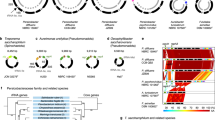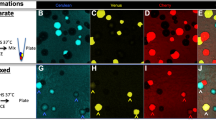Abstract
Only 10–20% of natural Escherichia coli strains can catabolize the pentitol sugars ribitol and D-arabitol1. This variability extends to common laboratory strains: E. coli C strains, but neither K12 nor B strains, can catabolize these sugars. In E. coli C, the genes responsible for these catabolic pathways are chromosomal and consist of two very closely linked, independent operons2. Genetic1 and hybridization studies (C.D.L. and A.M.R., unpublished data) indicate that the genes are completely absent in K12. These observations led us to consider whether these genes had been acquired by horizontal, rather than vertical, genetic transmission, perhaps as an inserted transposable element. Here we report that the ribitol-arabitol genes of E. coli C are surrounded by 1.4 kilobase (kb) inverted repeats of imperfect homology. These genes may constitute an example of a vestigial transposable element recently acquired by the bacterial chromosome.
This is a preview of subscription content, access via your institution
Access options
Subscribe to this journal
Receive 51 print issues and online access
$199.00 per year
only $3.90 per issue
Buy this article
- Purchase on Springer Link
- Instant access to full article PDF
Prices may be subject to local taxes which are calculated during checkout
Similar content being viewed by others
References
Reiner, A. M. J. Bact. 123, 530–536 (1975).
Scangos, G. A. & Reiner, A. M. J. Bact. 134, 492–500 (1978).
Kleckner, N. Cell 11, 11–23 (1977).
Calos, M. P. & Miller, J. Cell 20, 579–595 (1980).
Davis, R. W., Botstein, D. & Roth, J. R. in Advanced Bacterial Genetics, 114–115 (Cold Spring Harbor Laboratory, New York, 1980).
Ohtsubo, H. & Ohtsubo, E. Proc. natn. Acad. Sci. U.S.A. 73, 2316–2320 (1976).
Tye, B.-K., Chan. R. K. & Botstein, D. J. molec. Biol. 85, 485–500 (1974).
Rigby, P. W. J., Dieckman, M., Rhodes, C. & Berg, P. J. molec. Biol. 113, 237–251 (1977).
Hyman, R. W., Brunowski, I. & Summers, W. L. J. molec. Biol. 77, 89–96 (1973).
Shaw, K. J. & Berg, C. M. Genetics 92, 741–747 (1979).
Neuberger, M. S. & Hartley, B. S. J. molec. Biol. 132, 435–470 (1979).
Inderlied, C. B. & Mortlock, R. P. J. molec. Evol. 9, 181–190 (1977).
Cambell, A. A. Rev. Microbiol. 35, 55–83 (1981).
Bobrowski, M. M. et al. J. Bact. 125, 149–157 (1976).
Arber, W. & Linn, S. A. Rev. Biochem. 38, 467–500 (1969).
Deonier, R. C. & Hadley, R. G. Nature 264, 191–193 (1976).
Chow, L. T. in DNA Insertion Elements, Plasmids and Episomes (eds Bukhari, A. I., Shapiro, J. A. & Adhya, S. C.) 73–79, (Cold Spring Harbor Laboratory, New York, 1977).
Kleckner, N., Barker, D. F., Ross, D. G. & Botstein, D. Genetics 90, 427–450 (1978).
Southern, E. M. J. molec. Biol. 98, 503–517 (1975).
Botchan, M., Topp, W. & Sambrook, J. Cell 9, 269–287 (1976).
Author information
Authors and Affiliations
Rights and permissions
About this article
Cite this article
Link, C., Reiner, A. Inverted repeats surround the ribitol–arabitol genes of E. coli C. Nature 298, 94–96 (1982). https://doi.org/10.1038/298094a0
Received:
Accepted:
Issue Date:
DOI: https://doi.org/10.1038/298094a0
This article is cited by
-
Genotypic exclusion: A novel relationship between the ribitol-arabitol and galactitol genes of E. coli
Molecular and General Genetics MGG (1983)
Comments
By submitting a comment you agree to abide by our Terms and Community Guidelines. If you find something abusive or that does not comply with our terms or guidelines please flag it as inappropriate.



